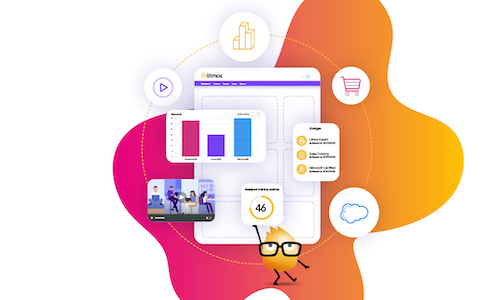How to Align Sales and Revenue Enablement
In today’s competitive business landscape, organizations are constantly seeking strategies to boost revenue and stay ahead of the curve. Two critical components that play a pivotal role in achieving this goal are sales enablement and revenue enablement. While these terms are often used interchangeably, they encompass distinct concepts that, when aligned, can significantly enhance an organization’s revenue generation capabilities.
This blog delves into the intricate relationship between sales and revenue enablement, highlighting their differences, their synergistic effects, and practical tips to achieve alignment between these two vital functions. By leveraging the power of sales enablement and revenue enablement, organizations can empower their sales teams, optimize revenue generation, and gain a competitive edge in the market.
Are sales enablement and revenue enablement the same thing?
Not exactly. While they are related concepts, they have distinct meanings and encompass different aspects of an organization’s revenue-generating strategy. Let’s delve into the differences between these two crucial business functions.
What is sales enablement?
Sales enablement, as the name suggests, focuses solely on empowering sales teams to achieve their full potential. It involves providing them with the necessary resources, tools, training, and support to enhance their sales performance. This includes equipping sales representatives with trainings that may cover in-depth product knowledge, effective sales methodologies, and soft skill development. Sales enablement may also mean providing access to existing customer data and analytics, to foster an adaptive selling approach. By prioritizing sales enablement, organizations can increase individual sales productivity and team effectiveness, ultimately driving revenue growth.
What is revenue enablement?
Revenue enablement takes a broader perspective than sales enablement. It encompasses not only sales training and sales enablement, but also marketing and customer success training and enablement. In essence, revenue enablement seeks to align all functions within an organization that contribute to revenue generation. This includes marketing efforts to attract and nurture leads, sales strategies to convert leads into customers, and customer success initiatives to lock in customer loyalty and outcomes. By fostering cross-functional collaboration and ensuring that all teams are working towards a unified goal, revenue enablement aims to maximize overall revenue growth, profitability, and long-term customer value and satisfaction.
Sales enablement is crucial for optimizing sales performance, by empowering the sales team with the tools they need to close deals. However, the teams involved in the initial (marketing) and final (post-sales) stages of the customer journey are often enabled differently. This can make sales enablement feel like a silo and can put the sales team at risk of ignoring pre- and post- sales functions as part of the sales process; likewise, keeping sales enablement separate can leave marketing and CX teams in the dark about how sales fits into the overall buying cycle. Taking a more holistic approach by training everyone involved in revenue generation, can lead to better customer experience, less churn, and ultimately, more revenue!
Why revenue teams need an LMS for enablement
Many businesses take a siloed approach to the software each revenue team uses – with sales teams using sales software, marketing teams using a Content Management System (CMS), and CX teams using Customer Relationship Management (CRM) software. However, all teams that contribute to revenue generation require a centralized, easy-to-use learning management system (LMS) that can provide access to relevant and timely training materials they need. When teams can’t cross-functionally collaborate to reach common learning and sales goals, revenue suffers. Which is why revenue leaders should consider implementing an LMS across the enterprise, to enable revenue team members, track employee progress, and measure the effectiveness of their training and enablement programs.
An LMS can be used to create personalized learning paths for each sales rep, based on their individual needs and strengths. This ensures that reps receive the training that is most relevant to them, which can help them to improve their performance more quickly. An LMS can also deliver training in a variety of formats, including videos, articles, quizzes, and simulations, to accommodate different learning needs and goals
Finally, an LMS can automate the sales training process, freeing up sales managers to focus on other tasks. For example, an LMS can automatically assign training courses to sales reps, track their progress, and send out reminders when training is due. This can save sales managers a lot of time and effort, and it can also help to ensure that sales reps complete their training on time.
In short, an LMS is a valuable tool for sales enablement that can help sales teams to improve their performance, increase their sales, and achieve their goals.
Getting leadership buy-in for sales enablement strategies
Revenue leaders understand the critical importance of sales enablement, but may not have all of the information they need to enthusiastically invest in new learning management systems for sales training. But leadership buy-in is the key to ensuring the success and widespread adoption of your sales enablement strategy.
Here are four ways to get buy-in from revenue leaders for your sales enablement strategy:
- Show them the data. Revenue leaders are numbers-driven, so it’s important to present them with data that shows the potential benefits of sales training and enablement. This could include data on increased sales, improved customer satisfaction, or reduced training costs.
- Get their input. Involve revenue leaders in the planning and implementation of your sales enablement strategies. This will help them feel invested in the process and more likely to support it.
- Make it easy for them. Revenue leaders are busy people, so make it easy for them to support your sales enablement initiatives. This could mean providing them with regular updates on progress, or creating tools and resources that they can easily access.
- Celebrate their successes. When your sales enablement strategies are successful, be sure to celebrate those wins publicly. This will help salespeople and partner re-sellers feel appreciated, while giving revenue leaders more reason to continue supporting your initiatives.
Tools to align sales and revenue enablement
There are several tools that can help you align sales and revenue enablement. These tools can help you manage your sales team, track their progress, and measure their success. Some of the most popular tools include:
- Learning management systems (LMS): As we’ve discussed above, an LMS can help you train your sales team and track their progress, while giving you key insights for identifying skills gaps and improving sales outcomes. The right LMS for sales enablement should offer sales-focused modern training tools such as:
- Mobile learning for Android and iPhone. Litmos has mobile learning apps that salespeople can access either online or offline, in their native language.
- Engagement features. Litmos’ Boost feature tests for learner engagement with random questions sent to the salesperson’s dashboard. Litmos’ mobile learning options also serve push notifications to help salespeople stay up to date on their training.
- AI capabilities. Litmos’ AI video feature allows you to test your sales teams on their elevator pitch, product knowledge, or overall sales skills.
- Robust reporting: Sales managers can monitor learner progress through Litmos reports and notifications, to help them provide real-time feedback. Accessing on-demand insights into learning performance metrics (grades, completions, overdue assignments, etc.) can empower managers to provide more tailored sales coaching and mentorship.
- Customer relationship management (CRM) software: A CRM system can help you manage your customer data, track sales and marketing opportunities, and automate your customer, sales, and marketing processes. When choosing an LMS, make sure to explore what CRM integrations are offered by the LMS provider.
Litmos offers multiple CRM, HRIS and business management software integrations, including Connector for Salesforce, which allows sales teams to integrate training into the flow of work, view training and sales data together, and define business rules for course recommendations within leads and opportunities. - Content management systems (CMS): A CMS can help you create and manage your sales content. However, you may not need a CMS if your LMS includes content authoring tools or a library of off the shelf courses.
The Litmos content authoring tool can be used to create custom sales onboarding modules that are tailored to the specific needs of your business. It features an easy to use drag and drop interface that allows users to quickly and easily create engaging training materials. Litmos also offers a robust library of sales training courses, covering soft skills, as well as more in-depth leadership topics like innovation, strategy, pragmatism, and multi-generational management. - Data analytics and reporting tools: Data analytics and reporting tools can help you track your sales team’s performance, measure the success of your sales enablement efforts, and learn from your data. Many organizations use reporting tools outside of their LMS to record sales metrics. However, investing in an LMS that integrates with your existing sales software can help your team keep track of learning and sales metrics in one easy-to-access, centralized location.
By using one or more of the tools above, or integrating them into an LMS, you can give your sales team the resources they need to be successful and achieve your revenue goals.
How to measure the success of your sales enablement strategy
Measuring the success of your sales enablement strategy is crucial to understanding its impact on your business. Here are four key metrics you can track to evaluate its effectiveness:
- Sales performance: Compare your sales results before and after implementing your sales enablement strategy. Look at the number of deals closed and the amount of revenue generated. Have these metrics improved? If so, your sales enablement strategy is likely contributing to your success.
- Sales rep productivity: Assess whether your sales reps are more productive and efficient after implementing your sales enablement strategy. Are your sales reps spending less time on administrative tasks and more time selling? If so, your sales enablement strategy is helping your sales reps make the most of their time.
- Sales rep feedback: Get feedback from your sales reps on the effectiveness of your sales enablement strategy. Do they find the resources and tools helpful? Do they feel more confident and knowledgeable in their roles? If so, your sales enablement strategy is meeting their needs and helping them succeed.
- Competitive analysis: Compare your sales results to those of your competitors. Are you growing faster? Are you gaining market share? If so, your sales enablement strategy is giving you a competitive edge.
- Time to close: Are the sales reps closing deals faster? Are they progressing deals through each stage more quickly than in previous quarters? If so, your sales enablement strategy could be reducing friction in the sales process and helping your salespeople get to “yes” more quickly.
By tracking these metrics, you can measure the success of your sales enablement strategy and make adjustments as needed, to ensure it continues to deliver results.
Training is the key to align sales and revenue enablement
Sales enablement and revenue enablement are distinct but complementary concepts that, when aligned, can have a significant impact on an organization’s revenue generation.
To ensure alignment between these two functions, organizations should leverage modern sales training and enablement tools, like those found in an LMS. Empowering your sales teams to perform at their best starts with providing relevant, timely, and easy-to-use learning resources. Aligning your organization’s larger learning, sales, and revenue goals may sound like a lofty undertaking, but it is possible with the right tools. Measure sales enablement outcomes against the goals your leadership identifies at the outset – such as sales performance and sales rep productivity – and address performance gaps through continuous learning to keep your sales enablement strategy on track and aligned with the greater revenue goals of your organization. By treating training as a tool for powering revenue generation throughout the extended enterprise, organizations can ensure that their sales enablement efforts are delivering the desired outcomes.
Discover how your organization can drive revenue through training the extended enterprise. Our latest eBook, Rev Up Revenue: Sales Training for Every Career Stage provides insights on how to support training at every stage of a revenue team member’s career.




